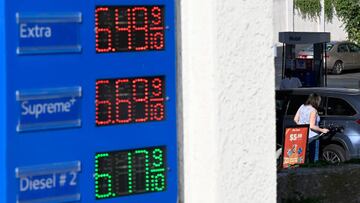Gavin Newsom announces bill to penalize oil companies and engaged in price gouging
What impact would a windfall profits tax have on drivers? We took a look at the response from the gas industry as California looks to implement one.


Leaders in the Golden State unveiled a new bill Monday to penalize oil and gas companies for what they see as price gouging masked by talk of worker shortages, logistical challenging, and a lack of refining capacity.
For many, the most powerful the proposal is that it would allow the state to tax these big players operating in California if their margins are deemed excessively high.
BREAKING: We just announced America’s first price gouging penalty on big oil.
— Gavin Newsom (@GavinNewsom) December 5, 2022
We will not be gaslit by oil companies that are keeping gas prices high while they rake in record profits.
Time for them to answer for ripping you off.
The funds collected would enter a Price Gouging Penalty Fund and be returned to drivers who have paid more for gas than any other state. The legislature must determine what the state will consider the acceptable “maximum margin” for refiners, as well as the penalty applied once this upper limit has been reached. The name for this sort of initiative is a windfall profits tax, and, as to be expected, is opposed by the oil and gas sector.
The industry group representing the interest of refiners, the American Fuel & Petrochemical Manufacturers (AFPM), says that while the measure “might make for good soundbites, but as policy, it’s bad for consumers.”
Their justification? Taxing profits may “disincentivize fuel production and make matters worse for drivers.” Taking this argument to its logical conclusion implies that unless the industry can manipulate supply and prices to increase its profit margins, it will decrease production to drive up prices through scarcity.
The AFPM did not attempt to underplay the extent to which price gouging was happening and instead promoted the idea that the practice is, actually, good for drivers, or at a minimum, better than the steps companies would take if their practices were to be regulated.
How else does the bill prevent price gouging?
The California bill expands the power of state agencies to look into the financials of oil and gas companies, giving firms a chance to explain why they are increasing prices. If the law is passed, the California Energy Commission and the California Department of Tax and Free Adminstration would be vested with new authority to “investigate and obtain information on costs, profits and pricing so that the state can better address the causes of pricing irregularities and minimize the likelihood of future supply or price shocks.”
Unlike the tax, these oversight functions are more difficult for the industry to rail against, considering many of the documents should already be available to comply with federal laws and as inputs to executive decision-making.
Unseen profits for the five top refiners in California
Before 2022, the four largest refiners in the state, Valero, PBF, Phillips 66, and Marathon, had never seen their profit margins exceed fifty cents a gallon... in the second quarter of this year, these companies were making around seventy-three cents per gallon. In quarter three, those margins increased to an average of eighty-six cents.
The industry has defended its margins by saying that what constitutes “profits” are being misconstrued by lawmakers to win political points.
This point is never defended and instead stated as a fact, often followed by attempts to blame the high gas price on California’s higher fuel standards, the state’s cap and trade system, and other state-wide and local regulations.
When watchdog groups calculate these totals, they are not only looking at revenue, they also account for operational costs, which have increased for many firms. However, even when these costs are accounted for, profits have quadrupled since 2021. What is interesting is that just as these companies have taken in historic revanue, the US Energy Information Adminstration has noted a very small amount being allocated towards capital expenditure to increase production. Instead, the Texas-based refiner, Philips 66, announced in November a plan to expand shareholder returns by $10 to $12 billion by “the end of 2024 through a combination of dividends and share repurchases.”
A question for industry and government leaders may be: should shareholder returns be prioritized over efforts to decrease environmental contamination? Private firms are fully within their legal right to return profits to shareholders. Still, if companies are less willing to focus publically on this practice and instead blame high prices on environmental regulation and not their price-setting power, the arguments are a bit disingenuous. The message from industry is often that government officials should examine how their policies negatively impact prices, but as it turns out, Governor Newsom and other leaders have the same message for refiners and retailers.
Environmental taxes do not explain differences in prices at the pump in California vs. the national average
Related stories
UC Berkeley professor Severin Borenstein spoke with PBS about the elevated prices that Californians were paying and the role increased environmental regulation and taxation were playing. Borenstein admitted that these costs are “definitely a part of it,” but that “when you add all that up, right now, that accounts for about 85 cents a gallon.” Drivers in the state were, for a large part of the year paying two dollars or more compared to those in other states, meaning that fuel standards, the cap-and-trade program, and other taxes could not explain the entire difference.
For Borenstein, the lack of competition branded gas retailers like Shell and Chevron face in the state could be an explanation. Compared to other states, “California has a much smaller share of off-brand stations than the rest of the country,” said Borenstein, and that means that “we’re not seeing the discipline enforced on competition that we would in other parts of the country, where those stations make up a bigger share.” Increasing market competition is one way that consumer advocates believe could drive down prices in the long run by breaking up the price-setting power the current major players have.